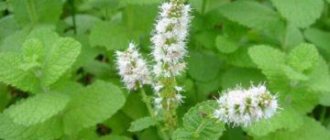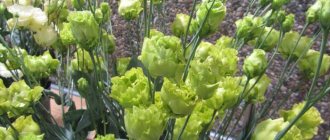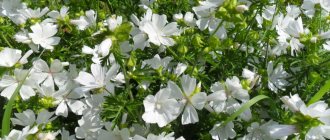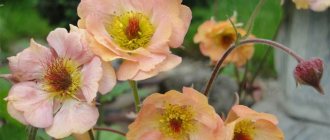Introduction
There are several leading companies in the world engaged in eustoma breeding. In the Russian Federation, mostly seeds from these producers are sold, but packaged by local companies.
Because of this, confusion often arises in the names of varieties. Therefore, we will present international names presented on the official websites of breeders. In most cases, varieties are named after a color, and this color is included in several collections.
Eustoma varieties are divided into five groups depending on the timing of flowering.
Group “0” – very early, “1” – early, “2” – middle, “3” – late, “4” – very late. Some manufacturers distinguish four groups, without the “super early” one.
Lisianthus varieties are most often bred from the species Eustoma Russellianus (Russell), formerly called Grandiflorum or Eustoma large-flowered.
White
Series "Echo" (Echo) variety "Pure White". A tall variety (60-80 cm in height) suitable for growing at home and in the garden for cutting. The first group of flowering, large double flower (5-6 cm) pure white.
“White” from the “Rosita” series (Rosita, 1, 2, 3 and 4). New big collection. A tall variety (80-100 cm) with a medium-sized double flower in the shape of a rose. An excellent variety for cutting and making bouquets.
"Ivory" (Ivory) in the line "Carmen" (Carmen). The color translated is “ivory”. A low-growing variety (15-25 cm) from the popular series of “indoor” eustomas. A simple white flower.
"Sapphire White" (Sapphire white or white sapphire). A low-growing variety for growing at home. Pot 10-20 cm, plant height 13-15 cm, simple flower. Eustoma “Sapphire white” is a real mini rose.
“White” (White), series “Rosie” (Rosie). A low-growing plant 15-25 cm high with a fully double flower. Attractive white eustoma for true connoisseurs.
Other varieties
Other popular varieties are all called “White” by default and differ in series. Therefore, we will list the series and flowering groups and if there are Russian names.
- Tall varieties are simple: “White Mermaid” (“White” from the “Mermaid” series), “Piccolo” (Piccolo, 1, 2 and 3).
- Tall terry: "Alissa" (Alice, 1), "Borealis" (Borealis, 0), "Excalibur" (Excalibur, 2 and 3), "Mariachi" (Mariachi, 2). "ABC" (ABC, 1 and 3), "Flare" (Flae, not specified). “Arena” (Arena, 2), “Corelli” (Corelli, 2), “F1 Croma” (Croma, 2 and 3), “Super Magic” (Super Magic, 2).
- Low-growing simple ones: “Silver” from the “Florida” series (Florida).
When to plant and which seeds are best to choose
Eustoma differs from many plants in that it reproduces exclusively by seeds. This is due to the fact that cuttings never produce roots, and an underdeveloped root system will not allow the plant to be propagated by dividing the bush. As a result, it will simply die.
Seed cultivation of Irish roses is a labor-intensive process. The seeds are very small and do not have high germination rate, it usually does not exceed 30%.
Eustoma seeds are extremely small and difficult to plant.
Having decided to plant eustoma, you need to carefully select the seed:
- It is better to buy seeds from trusted manufacturers and specialized stores;
- Preference should be given to those treated with a special gel. This increases seed germination by up to 40% and simplifies the sowing process.
The timing of planting is influenced by the region in which the flower is grown and the position of the moon at the time of planting. For the northern regions, January is considered the deadline, and in the southern climate zone, seedlings can be planted in March.
Table. Favorable and unfavorable days for sowing in 2019 according to the lunar calendar
| Month | Favorable days | Unfavorable days |
| March | 7, 10, 11, 12, 14, 15, 16, 19, 20, 21 | 3, 4, 5, 6, 13, 17, 18, 22, 30, 31 |
| November | 9, 14, 21, 22 | 1, 2, 7, 14, 15, 23, 28, 29; |
| December | 3, 4, 5, 8, 9, 10, 11, 12, 27, 31 | 2, 3, 4, 7, 8, 10, 17-19, 21, 22, 23, 26 |
Green
“Lime Green” (Lime green) from the “Mariachi” series. Tall variety (75-90 cm) with large (5-7 cm) extra-double flowers of light green color. Second group of flowering.
“Green” (Green) from the “Super Magic” series, we know as eustoma “Green Alley” from. A tall variety with large double flowers with a pale green tint and a medium flowering period.
"Green" (Green) from the episode "ABC 1". Tall variety (80-100 cm). Large double inflorescences of greenish color. Strong stems and high storage stability.
Other varieties
- Tall simple: "Piccolo" (Piccolo, 2 and 3).
- Tall terry varieties: “Alissa” (Alice, 2), “Rosita” (Rosita, 1, 2 and 3), “Advantage” (Advantage, 2), “Arena” (Arena, 3), “F1 Croma” , 1 and 3).
Yellow
“Yellow” (Yellow), series “Echo” (Echo). Tall variety (70-90 cm) with a standard double large flower. First group of flowering. Legendary series with good reviews. Excellent option for cutting.
"Yellow" (Yellow) from the series "ABC 1 and 2". In Russia it is also sold as "Madge Yellow" from. Tall variety (80-100 cm) with large double yellow inflorescences.
"Yellow" (Yellow), series "Super Magic" (Super Magic). Tall variety (70-90 cm). Large double yellow flowers. First and second group of flowering.
Other varieties
- Tall varieties are simple: “Piccolo” (Piccolo, 2).
- Tall terry: "Alissa" (Alice, 2), "Aube" (Aube, 3), "Borealis" (Borealis, 0), "Excalibur" (Excalibur, 3), "Mariachi" (Mariachi, 2), "Rosita "(Rosita, 3 and 4), "Advantage" (Advantage, 2), "Gold" in the "Arena" series (Arena, 3), "Corelli" (Corelli, 3), "Croma" (Croma, 3).
- There is also a fairly popular Twinkie Yellow variety from, but we were unable to find information among global producers. According to the packaging: plant up to 50 cm in height with large simple yellow flowers.
Red
“Carmine” (Carmine or carmine) from the “Mariachi” series (Mariachi, 2nd flowering group). Lisianthus has extra-double large flowers (5-7 cm in diameter) of red color, very similar to a rose. An excellent variety for making bouquets. The height of the bush is 76-96 cm. According to reviews, the flowers tolerate transportation well and last a long time in a vase.
“Red” from the “F1 Arena” series (F1 Arena). Tall variety (70-90 cm) with double large flowers (6-7 cm in diameter) from dark pink to light red or cherry shade. The third group of flowering.
- Today we cannot recommend other proven modern varieties of red eustoma.
Growing in a flowerbed
In order for the beauty to feel good in the flower garden, planting is planned in the right place. The place for the flower should be well lit by sunlight and have fertile soil. Just take into account that direct rays of the sun hitting flowers and leaves is destructive. For favorable cultivation, it is recommended to choose a site close to the crowns of ornamental or fruit trees.
After May 15, seedlings can be planted in the flower garden. The seedling is ready for transplanting when 5–8 true leaves form on the stem. The flower has a bush-like shape, and a distance of 10-15 cm should be left between the plants. Before planting, the plants are watered so that they can be removed from the pot along with a lump of earth. Holes are prepared in the flowerbed, the size of which corresponds to an earthen coma. The hole is watered with water, allowed to soak into the soil, and the eustoma with a lump of earth is carefully placed. The planting depth should correspond to that at which the plant grew before transplanting.
After planting, the hole is filled with soil. The plant is covered with half of a light plastic bottle.
This will protect against nighttime temperature changes. Also, the shelter will not allow moisture to quickly evaporate. Such a covering will allow the seedlings to adapt to new conditions in three weeks. 10 days after transplantation, the cover is removed during the day and put back at night. After another 10 days, the cover is completely removed.
Watering and fertilizers
Seedlings should be watered sparingly, as overwatering will lead to rotting of the roots.
Feeding of young plants begins after the seedlings have rooted, approximately a month after transplantation. During the growing season, the plant extracts the entire complex of nutrients from the ground, so it must be fed with special fertilizers. They should contain phosphorus, potassium and small doses of nitrogen substances. The best option would be a complex fertilizer, for example, ammophos, which is completely soluble in water. You need to feed the flowers at least twice.
We recommend studying: how to properly grow perennial mallow from seeds?
Bloom
Eustoma begins to bloom in the second decade of July and ends flowering in October. At first, the stem begins to branch strongly from the middle, then up to 20-30 buds are formed on each branch. One flower will bloom for about two months if it is not cut and placed in a vase. And if the eustoma is cut off, it begins to grow back from the root and blooms a second time. When autumn is warm, you can observe the second abundant flowering of eustoma.
Collecting seeds
Flowers are easily pollinated, and after a while boxes with numerous small seeds are formed, characterized by high germination. Seeds can be collected if an F1 hybrid is grown. The second generation of the flower is basically similar to the parent bush, but some differences also appear.
Diseases and pests
To protect against diseases during the growing process, it is necessary to carry out preventive spraying with fungicidal preparations. When the summer is rainy, they spray it with foundationazole. This will prevent and treat fusarium wilt, gray rot, and powdery mildew.
Harmful insects for eustoma are aphids, slugs, and whiteflies. To destroy pests, use confidor, actellik, actara, fitoverm.
Reproduction by rhizome
To save time, you can buy already grown eustoma seedlings. But when buying, you need to know the features of the root system. The rhizome of this beautiful flower is fibrous, highly branched with thin and very fragile roots. These roots break off easily; when the soil becomes waterlogged, they begin to rot and are attacked by nematodes and rot.
The roots are not buried in the soil, but are located almost at the surface of the soil. And if, when weeding, you touch the root system and break off the fragile roots (and this is easy to do), then the plant begins to wither and simply dies from moisture deficiency.
Therefore, it is important to replant with a ball of earth in order to preserve all the branched roots. You need to buy eustoma seedlings in garden stores or nurseries. The root system should only be closed.
Rhizome division
In the flowerbed the bush is growing strongly. In the fall, it can be trimmed, planted in a wide container and wintered in a cool room (8–10°C). With the arrival of spring, sprouts will begin to form from the roots. After spring frosts, you can propagate the flower by dividing the rhizome into parts.
The roots of the eustoma are watered with a weak manganese solution and left for 2 hours. Next, the rhizome is divided into 2-3 parts by hand. These parts must have sprouts and full roots. Fractures must be treated with crushed activated carbon. They also moisten the separated parts with root.
Parts of the eustoma are planted in shallow, wide holes. A drainage layer of 10-15 cm must be laid on the bottom. The holes are filled with nutrient substrate to 1/3 on top and seedlings are installed, covering them with soil. Water the plants generously with a foundation solution so that all voids are filled. When the liquid is absorbed, add soil. After 10 days, watering with foundationazole is repeated.
After planting on the second day, the top crust of the soil is loosened and a layer of five-centimeter mulch is laid.
Young plants need to be shaded from the scorching rays of the sun. It is good to plant a tall eustoma near a moisture-loving hosta. It will additionally shade the surface of the earth, improving the microclimate.
We recommend studying: the best varieties of Weigela according to our expert with cool photos
Pink
“Deep Rose” (Deep Rose) from the American series “Flare” (Flae, translated as flash). On sale it is referred to as “Laguna Deep Rose”, only in the photo it looks more saturated in color. Tall variety of the second flowering group. Terry pink flower.
“Pink” (Pink), series “Echo” (Echo). Tall variety (70-90 cm) of the first flowering group from the famous series. Standard double flower. One of the most popular pink eustomas for growing as cut flowers.
"Misty Pink Mariachi" Tall collection (up to 100 cm) “Mariachi” with an extra-double flower reminiscent of a camellia. Light pink eustoma is perfect for making bouquets. Second group of flowering.
"Deep Rose" from the ABC 1 episode. We sell the variety under the name “Maidge Deep Rose”. Tall variety for cutting, 80-100 cm high, with double flowers of light pink color.
"Rose" in the collection "Carmen" (Carmen). Low-growing indoor eustoma (15-25 cm) pink. Simple flower. High-quality root system. Resistant to fusarium.
“Pink” (Pink), series “Florida” (Florida). A low-growing variety (20-25 cm), which can be grown in open ground, a greenhouse and at home (a pot of at least 12 cm in diameter). A popular series with the most resistant varieties to summer heat in the garden. Light pink color.
“Pink” (Pink) from the series “Rosie” (Rosie). A low-growing plant (15-25 cm) with a strong root system, which is suitable for growing as a houseplant. Fully double flower of delicate pink color.
Other varieties
- Tall varieties are simple: “Rose Pink” (Rose pink, 2 and 3) series “Piccolo” (Piccolo).
- Tall terry: "ABC" (ABC, 2 and 3), "Alissa" (Alice, 1 "Rose" and 2 "Pink"), "Arena" (Arena, 1, 2, 3 and 4), "Cocktail Champagne" (Champagne cocktail) in the “Aube” series (Aube, 3), “Borealis” (Borealis, 0), “Corelli” (Corelli, 3), “Rose Pink” in the “Excalibur” series (Excalibur, 2 ), “Mariachi” (Mariachi, 2), “Clear Pink” (Klia pink) series “Robella” (Robella). Series "Rosita" (Rosita): "Rose Pink" (Rose pink, 1, 2 and 4), "Pink" (Pink, 2 and 3) and "Pink Flash" (Pink Flash, 3), "Super Magic" ( Super Magic, 2).
- Light pink lisianthus "Champagne" (Champagne) in the collection "Echo" (Echo), "Misty Pink" (Misty pink) from "Mariachi" (Mariachi, 2) and "Rosita" (Rosita, 2), "Rose" ( Rose) from "ABC" (ABC, 2), "Corelli" (Corelli, 2 and 3).
Planting gentian at home for seedlings and caring for it
Tall varieties are perfect for growing on site. During the period of active flowering, they will decorate the garden with luxurious flowers, which, when cut, will last at home for up to two weeks. Preparations for planting in open ground begin long before spring with the cultivation of seedlings.
When to sow
It will not be possible to plant seeds directly into the ground on the site, especially before winter - eustoma does not tolerate temperatures below +10°C. The period from planting to flowering takes 22–26 weeks, so seeds should be planted for seedlings in December–February.
Can it be propagated by cuttings or roots?
Propagation by cuttings is possible only in theory; in practice they do not take root. The same thing happens when dividing the rhizome - the fragile roots of lisianthus react painfully to any damage. That is why dividing the bush can lead to the death of the entire plant.
As for propagation by bulbs, this is basically impossible, since lisianthus is a herbaceous plant and does not form bulbs.
If you are offered to buy lisianthus bulbs, walk away. At best, the seller is deluding himself, at worst, he is trying to deceive you.
Growing from seeds
Reproduction by seeds is perhaps the only really effective way to propagate eustoma. Planting seed material is sold in a wide range, although more recently it was available only to special farms involved in floriculture. The seeds of the plant are extremely small, one gram contains from fifteen to twenty thousand, so they go on sale in the form of pills. The shell serves as auxiliary nutrients that help in the development of the plant at the initial stage.
Due to their very small size, lisianthus seeds are sold in pelleted form.
How to till the soil and plant seeds
The soil for planting should be light, a commercially available mixture for Saintpaulia works well. Another option is to plant seeds in peat tablets. They are convenient because in the future you can dispense with transshipment into larger containers without damaging the sensitive roots of small lisianthus. How to prepare the soil yourself:
- Mix two parts peat moss with one part garden soil and half part sand.
- The soil must be sterilized, as the slightest infection can quickly kill the seedlings. To do this, the soil is spilled with boiling water and a strong (dark pink) solution of potassium permanganate.
- After the earth has cooled, the seeds are planted - laid out on the surface of the soil and lightly pressed down.
Sterilization is also required for containers in which seedlings are planted. Peat tablets are also treated with boiling water and potassium permanganate, after they have swollen to the desired size and cooled, they begin to plant seeds.
The seeds are laid out on the ground and pressed lightly
Planting process:
- The seeds are laid out on the surface of the prepared soil and lightly pressed down.
- After planting, you need to moisten the soil; it is convenient to use a spray bottle for this.
- The nutrient composition covering the seeds hardens after drying, which creates difficulties for weak shoots to germinate. To avoid such problems, after moistening the dragee, you can gently crush it with a toothpick, destroying the shell.
- The planting is covered with film or glass, you can use a container with a transparent lid, and placed in a well-lit place.
Planted seeds are sprayed with water
Caring for eustoma seedlings
Eustoma seedlings are very demanding of light; plantings should be placed on well-lit window sills. Seeds planted in winter need additional artificial lighting due to the short daylight hours. You can use a phytolamp (sold in stores that specialize in selling garden supplies); if you don’t have one, a regular fluorescent lamp will do. Seedlings should be under artificial light for up to 12–15 hours a day until approximately the end of March.
Seedlings should be kept under lighting at night in winter.
When germinating seeds, you need to ensure a favorable temperature regime . During the day, seedlings should warm up to 22–25°C, at night - no lower than 18°C. At first, you won’t have to moisten the germinating seeds very often, since in closed containers there will be enough evaporated moisture. If the soil dries out, carefully spray it with water from a spray bottle. Be sure to provide ventilation for the germinated seedlings by removing the lid from the container or removing the film for 5–10 minutes.
The first shoots appear approximately two weeks after planting the seeds. Germination of lisianthus is considered good if 40–50% of the planted seeds have germinated. After the first sprouts appear, watering should be carried out only in the morning, so that the stem and leaves have time to dry by the evening. This will reduce the risk of seedlings becoming infected with root rot. Approximately 5–6 days after germination, seedlings need to begin hardening off. On the first day, air baths are performed for 10 minutes, then the same amount is added every day. After reaching three hours, the film cover (container lid) can be removed.
Recent Entries
Lilac perennials that are beautiful, compact and do not crowd out other plants Why when buying seedlings you should not take the sellers’ word for it and how to determine the age of the plant using 3 signs Tomato seedlings have turned purple or whitish: why the color has changed and how to save the plants
When picking, plants are placed in separate containers
After two pairs of true leaves appear, 6–8 weeks after germination, the seedlings are planted in separate pots. The sprouts will be very small, but this is the normal appearance of a plant at this age. When picking, you need to carefully pick up the seedling with a toothpick along with a lump of soil and replant the baby separately. You should not delay picking; the rapidly growing root system is easy to damage. The soil for transplanted sprouts is taken the same as when planting. It does not need to be sterilized; it is enough to treat it with fungicides (antifungal drugs). Fundazol diluted in water at the rate of 1 gram per 1 liter of water is suitable.
After a month, the grown seedlings need to be transferred to larger containers . You need to act carefully, trying not to damage the roots.
- Place expanded clay drainage at the bottom of the container (layer thickness - 3 cm).
- Then soil is poured - about 4 cm (you need to focus on the size of the container and the plant itself).
- The sprouts are removed along with the soil and very carefully moved to a new container.
- Spread the soil along the walls of the container, lightly compacting it, being careful not to leave the root collar exposed.
- After transshipment, water.
In the future, it is important not to overwater or dry out the plants. Lisianthus should be watered when the top layer of soil dries out with warm water that has settled. It is strictly forbidden to spray growing eustomas with water - this leads to diseases of the leaves and stems.
The seedlings will grow in these pots before being transplanted into the garden.
If the seedlings grow slowly
Flower growers who breed eustoma note that in the first months, lisianthus grows very slowly. This is due to the expansion of the root system, after which the above-ground part begins to grow. Therefore, if it seems that the seedlings have stopped and are not growing in size, this is normal; after a couple of months, active growth of the plant itself will begin.
For more abundant flowering, you can pinch lisianthus at the stage of appearance of 5–6 pairs of leaves. This procedure will make the plant bushier.
Feeding seedlings
Seedlings can be treated with biogrowth stimulator Epin at the rate of 4 drops per 100 ml of water. The plants are sprayed after picking, timing them so that the leaves dry out by evening. After transplantation, the plant begins to be fed weekly; Agricola for flowering plants is suitable for this. It is better to use the liquid form of the fertilizer, diluting it with water according to the instructions. Many gardeners recommend slightly lower concentrations than those indicated by the manufacturers.
Video: growing lisianthus from seeds at home
Apricot (Apricot) and Champagne
Among the varieties of lisianthus there is a separate color called “Apricot” (Epricot or simply apricot), which is translated as “apricot”, as well as “Champagne” (Champagne). Varieties with these color names are found among many manufacturers. They are also described as coral or salmon in color.
"Apricot" in the "Corelli F1" line (Corelli F1). Also a tall variety (70-90 cm) with large double flowers of salmon-apricot color. The third group of flowering.
"Light Apricot" (Light Apricot) in the series "Alissa 2" (Alissa or simply Alice). An excellent tall variety (80-90 cm) for growing at home and for cutting. Large double flowers of a delicate coral shade with fringed petals.
"Light Apricot" (Light Apricot) from the collection "Falda F1" (Falda). Tall variety (70-90 cm) with simple medium-sized flowers of light salmon color. Second group of flowering.
"Champagne Arena" (Champagne "Arena"). Tall variety (80-10 cm). Popular series. Large double flower of high quality. Resistant during transportation. The third group of flowering.
“Champagne Echo” (Champagne in the “Echo” series). Tall variety with large standard double flowers. Suitable for cutting. First group of flowering. Eustoma “Echo Champagne f1” is the most popular among varieties of this color.
"Champagne Alissa" (Champagne "Alissa"). The tall variety (80-90 cm) of eustoma is distinguished by large double flowers with dense petals. Amazing color. Second group of flowering.
"Champagne Super Magic" (Champagne "Super Magic"). The plant is 70-90 cm in height with strong stems. Double flower of unusual color, medium size. Second group of flowering.
Growing Irish rose seedlings
Eustoma has been cultivated recently - since the 1980s. At first it was only a houseplant, but then gardeners became interested in it and gradually moved it to their plots.
In June, ready-made plants can be purchased in stores. They are immediately planted in the garden. In this case, planting is done first in containers. The plant blooms until frost.
When grown independently, planting occurs in February under film. In this case, the seedlings are kept in a warm place - the temperature should reach +20 degrees. It is better to choose light and sandy soil. Periodically spray with warm water. The seeds should not be deeply buried. You can plant eustoma in peat tablets. In this case, the transplant will be much easier. Care consists of providing the plant with long daylight hours and carrying out complex fertilizing.
After 3 leaves are formed, the seedlings are placed in separate pots. Then the boarding takes place immediately at the chosen place. Plants are shaded and watered periodically. Care involves constant spraying, especially in dry areas. However, excess moisture should be avoided. Important! The air in the greenhouse must be fresh, otherwise eustoma will not develop well.
Blue and blue
Among the varieties of eustoma it is difficult to find a blue or blue color in our understanding. By the name “Blue”, manufacturers mean lilac, lavender or dark purple color. We did find several varieties of lisianthus close to the blue and blue colors.
"Blue Flash" (Blue flash or blue flash) in the series "Robella" (Robella). A tall plant (80-100 cm) with a large double flower. Second group of flowering. An excellent option for growing at home and for cutting.
“Milka” (Milka), series “Piccolo” (Piccolo). A fairly new variety that has already settled in the hearts of many gardeners. Eustoma "Milka Piccolo" 80-100 cm in height. A simple flower of medium size. Second group of flowering. Delicate blue color of the petals.
“Blue” (Blue) in the series “Rosita” (Rosita, 3rd and 4th group). A new series with a medium-sized double flower resembling a rose. Eustoma "Rosita Blue" grows about 80-100 cm in height. The color of the inflorescence is very close to blue.
"Blue" (Blue) in the series "Corelli" (Corelli). Tall variety. Large double flower almost blue. Excellent for making bouquets. Lasts a long time in a vase. The third group of flowering.
Combination with other plants
Eustoma is popular with both florists and gardeners. The plant looks great in mono bouquets and flower beds. The best neighbors for her will be lilies, roses, tulips, and chrysanthemums.
Purple eustoma
We will separately consider the well-known varieties with the “Blue” color according to the manufacturers. And let's try to decide together what color they are? We believe that these varieties are much closer in color to purple than to blue.
Let’s start right away from the legendary “Echo” series and the “Blue” variety, or in simple terms – “Echo blue or blue f1”. Tall eustoma (60-80 cm in summer) with a double flower (4-6 cm) of blue-violet color. First group of flowering.
“Deep Blue” (Deep Blue), series “Flare” (Flae, translated as flash). It can be found on sale under the name “Laguna Deep Blue” from Tall lisianthus with a voluminous double flower of violet-blue color.
"Blue" in the "Mariachi" collection. Tall series (80-100 cm). Large extra double flower (5-7 cm) with pure purple color. Second group of flowering.
"Deep Blue" from the "Super Magic" series. Lisianthus grows 70-90 cm in height. Terry large flower of rich purple color with a dark blue core. Second group of flowering.
"Blue" (Blue) in the series "Florida" (Florida). A popular low-growing variety for growing in pots. A simple purple flower.
"Blue" from the "Mermaid" series. Our variety is also known as “The Little Blue Mermaid” from. Compact bush (13-17 cm) with a simple three-dimensional flower (5-6 cm).
"Sapphire Blue" (Blue or light blue sapphire). A popular series of low-growing varieties with simple inflorescences. It is popularly called a dwarf rose or mini-rose because the bush is only 13-15 cm high. Rich purple color.
"Blue Carmen" (Blue Carmen). Low-growing variety (15-25 cm). A simple flower of medium size.
"Lavender Blue" (Lavender Blue or blue lavender) from "Rosie" (Rosie). A low-growing variety with double flowers from dark blue to light purple.
“Lilac” (Lilac, translated lilac) in the series “Carmen” (Carmen). A low-growing variety (15-25 cm) with simple, medium-sized lilac flowers. Excellent bushiness. We sell it as “Carmen Lilac F1” from “Plasma”.
Light purple (lavender)
"Lavender" in the series "Mariachi" (Mariachi). A similar variety to the previous one, only with an extra-double light purple flower 5-7 cm in diameter and a second flowering group.
“Lavender” (Lavender) in the “Rosita” collection (Rosita, group 3). Huge new series in the 2022 catalogue. Tall variety (80-100 cm) with a medium-sized double flower. The inflorescence is shaped like a rose. Soft blue color.
"Lavender" in the Japanese line "Echo" (Echo) or the popular name "Echo Lavender". Tall plant (60-80 cm in height). Ideal variety for cutting. Early flowering - 22-24 weeks, first group. Large double flower (4-6 cm).
"Lavender" in the American series "ABC 2" (ABC, 2). Tall variety (80-100 cm). Large double flower. Light lilac color of dense petals. Lasts a long time in a vase.
How to control pests in the garden
This plant cannot be classified as a resistant plant. Most attention is attracted to this plant by mites, as well as slugs and other insects.
In order to minimize the risk of plant infection, periodic preventive maintenance is necessary.
Clarkia graceful - varieties and types, care and planting, diseases + 78 photos- Irises - description of the species, cultivation, reproduction + 102 photos
Campsis - planting, care, location rules, watering, types of reproduction (67 photos + video)
Brown and burgundy
In addition to popular colors of inflorescences, such as white, pink or purple, there are varieties of eustoma with a rather amazing palette of colors. We have selected several unusual varieties for you.
"Deep Brown" in the episode "Rosanne 2". A tall variety with a standard double flower, but of rare color. The color is translated as "dark brown", but it is described as lavender brown.
"Brown" in the series "Rosanne1". This variety is from the same series, only with the first group of flowering. It is difficult to describe the color palette of the inflorescence in one word. You can say lemon color, turning into a light brown shade with lilac notes or close to burgundy color.
"Pikoti" or two-color
Picotee refers to a special pattern in which the edges of the petals are painted a different color than the rest. Varieties called “picoti” are produced by many seed manufacturers, and they are often included in various series.
Varieties with a border of different colors and a white center are loved by gardeners around the world. However, the manufacturer warns that the variety may lose its colored edges and become a solid color depending on growing conditions.
White and pink “Pikoti”
"Pink Picotee lmp." (Pink Picoti lmp. in the “Echo” series (Echo, 1). A tall variety with a large double flower of white and pink color. A new variety in the famous “Echo” collection.
“Pink Picotee” (Pink Picotee) from the “Croma” series. Tall collection (80-100 cm). A pink flower with a white edge, very similar to a rose. The third group of flowering.
“Pink Rim” (Pink Rim) from the “Piccolo” collection (Piccolo, 1 and 3). Tall bush (80-100 cm) with a simple flower. In our country, the eustoma of this variety is often called “Piccolo Pikoti crimson”.
"Misty Pink" (Misty Pink), episode "ABC 2". Tall lisianthus with medium-sized double flower. Delicate pink color with white closer to the base of the inflorescence.
"Sapphire" (Sapphire). Dwarf variety measuring 13-15 cm in height. A simple flower with a delicate pink color. Excellent white and pink eustoma “Sapphire Pink Rome” is perfect for growing indoors.
“Rose Picotee” (Rose Picotee), series “Rosie” (Rosie). Low-growing variety 15-25 cm in height. A fully double flower is white with pink droplets on the edges of the petals.
Other varieties
- Tall simple varieties: “Hot Lips” (Hot Lips) in the “Piccolo” series (Piccolo, 2).
- Tall terry varieties "Pink Picotee" (Pink Picotee) of white and pink color in the collections "Aube" (Aube, 3), "Mariachi" (Mariachi, 2) and "Rosita 1". And also “Rose Rim” from ABC 1, Hot Lips from Rosita 2 and Excalibur.
- “Pink Rim” (Pink Rim or “Pink Haze” from the American series y) from the series
How to care for eustoma in an apartment
Low-growing varieties of lisianthus are ideal for growing indoors. Seed manufacturers offer a wide selection to suit every taste. Usually you can see marks on the seed packets indicating the height of the plant. Compact series will fit perfectly on the windowsill and will delight you with large, bright flowers.
Growing indoors
Planting seeds and the main stages of caring for germinating seedlings for indoor propagation are no different from growing seedlings intended for open ground. Everything has been discussed above. The only difference is that after transplanting the grown seedlings, they remain on the windowsill until flowering begins.
Eustoma feels comfortable in the temperature conditions of the apartment. The lighting should be bright, but without direct sunlight.
Table: seasonal conditions for keeping lisianthus at home
| Season | Temperature | Humidity | Watering | Top dressing | Illumination |
| Summer | +22оС…+24оС | Do not wet the leaves and stems by spraying. You can place trays of water next to the eustoma. | Sufficient, as the soil dries to a depth of 2 cm. Pour out excess water from the pan immediately. | Every week or every two weeks, apply fertilizers for flowering plants (Agricola - according to the instructions, the dosage can be taken a little less than indicated). | Bright light without direct rays hitting the plant. |
| Winter | +10о…+15оС | Do not moisturize. | Reduce. | Do not carry out. | Shaded place. |
It is not difficult to maintain lisianthus at home. The temperature in the apartment is quite suitable for the flower’s comfortable existence. It is better to determine the place for it on window sills facing west or east. Eustoma is a lover of light, but direct contact with the burning rays of the sun can damage leaves and flowers.
You can determine when to transplant the eustoma into a larger pot by the roots that begin to make their way through the drain holes of the pot. This indicates that the plant has become crowded. A container with a volume of 2–2.5 liters is enough for 3 plants, which will develop and actively grow throughout the growing season until they enter a dormant state.
Humid air is beneficial for the plant, but it is important to remember that leaves and flowers cannot be sprayed, as this can lead to rot. The best option would be to place a container filled with water next to the flower pot.
If you decide to leave the lisianthus for the next year, after flowering the stems are cut off, leaving three internodes, and watering is reduced.











